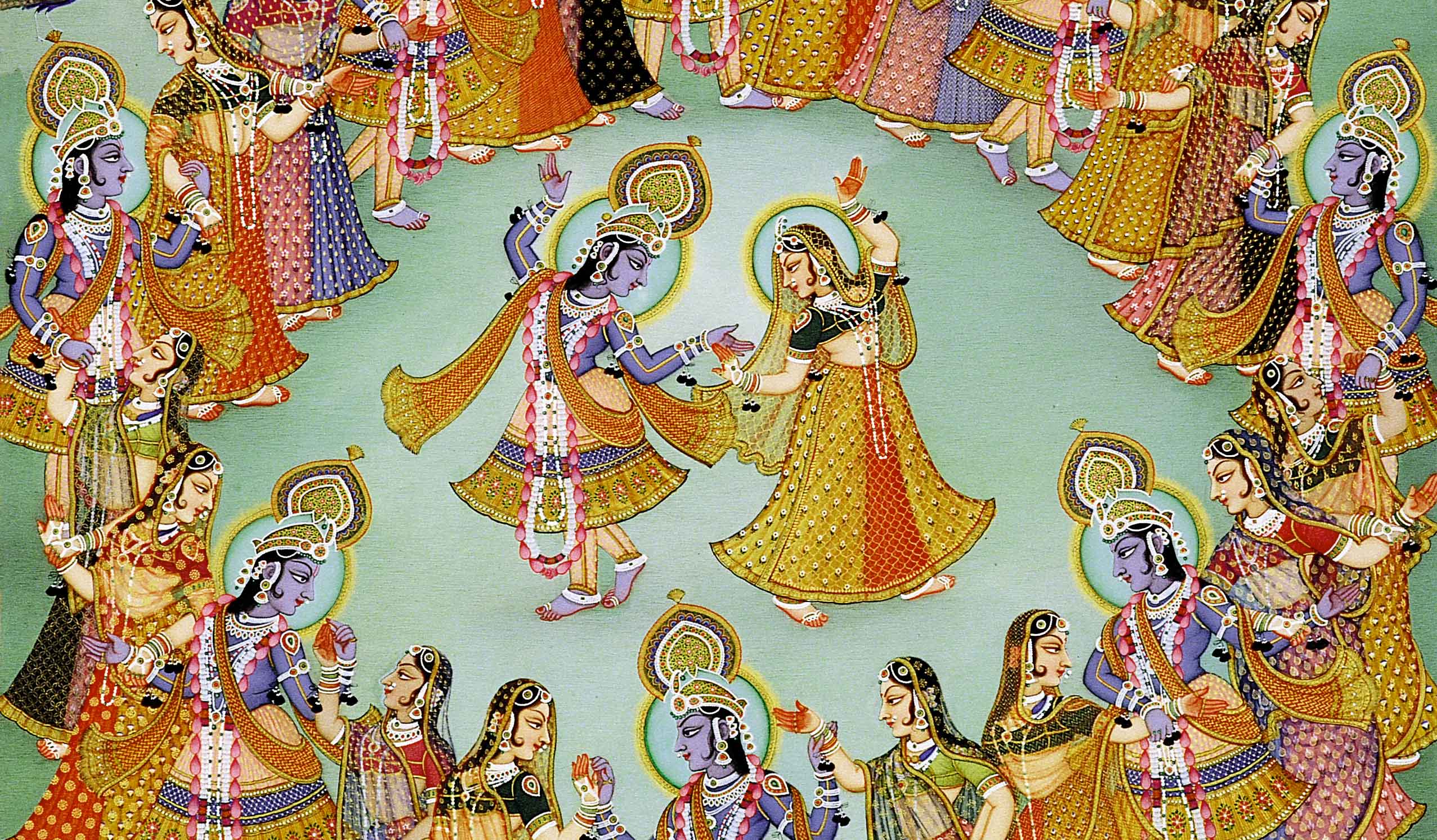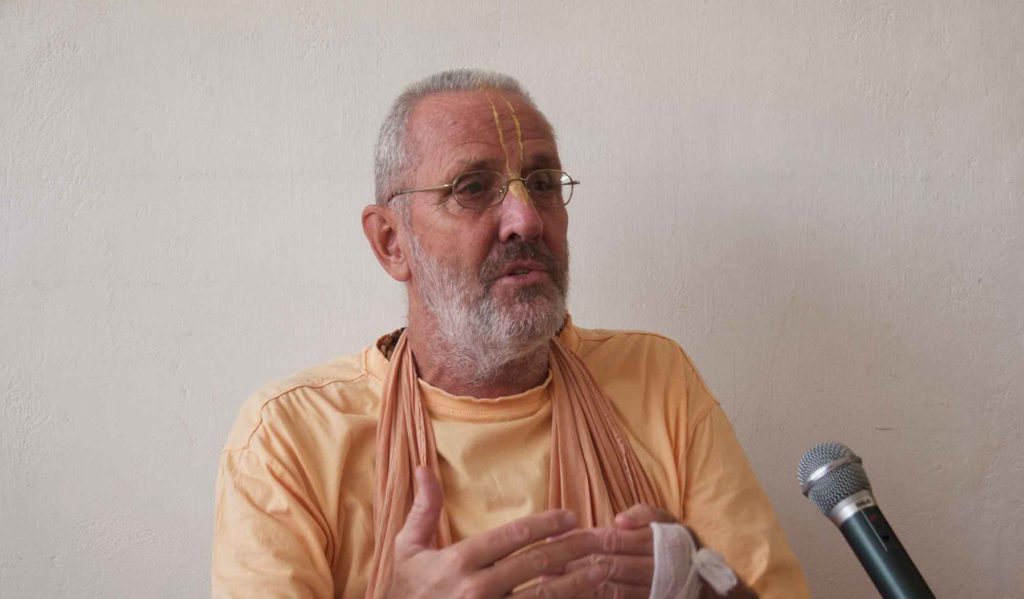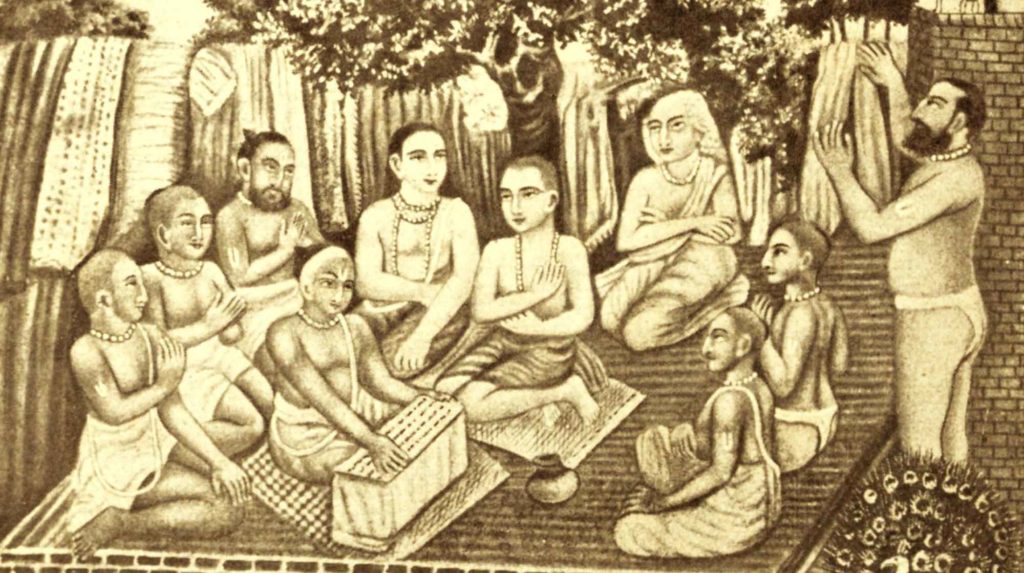Overview
This article 'Vikrīḍitaṁ vraja-vadhūbhir' was originally written by an unknown author under the editorship of Śrīla Bhaktisiddhānta Sarasvatī Ṭhākura Prabhupāda and first published in the 8th volume of Dainika Nadīyā Prakāśa on 29th October 1933 under the title, ‘Rasa Yātrā.’ The article explains the dangers of hearing higher topics for the conditioned jīvas and how Śukadeva Gosvāmī has himself warned about this.
Today is Rasa Pūrṇimā. Many people have gathered in Navadvīpa, Śāntipura, Vṛndāvana, Purī and other holy places. The purpose of these pilgrims is to take darśana of Śrī Kṛṣṇa’s rāsa-līlā. It is the opinion of those who are knowledgeable of their spiritual identity that there is no other greater sevā than this, and in this respect there is no doubt that it is everyone’s duty to endeavour to gain qualification for this sevā. Without first climbing the branch of a tree, trying to reach the fruits is a disturbance.
What tattva is Śrī Kṛṣṇa? What is our svarūpa? What is the tattva of Śrī Kṛṣṇa’s gopīs? What is our relationship with Them? Without knowing what is actually rāsa-līlā, then in our attempt to attain darśana of that rasa, we shall simply try to pursue our desire to enjoy. We will not pursue the real thing. Śrī Kṛṣṇa is aprākṛta-vastu (fully spiritual). We cannot comprehend Him through material knowledge. Neither the physical senses nor the knowledge acquiring senses are sufficient to attain knowledge of Kṛṣṇa. Those vraja-gopīs with whom Kṛṣṇa performs His rāsa-līlā, are just like Śrī Kṛṣṇa in that they are inaccessible to material intelligence. So long as there remains a fraction of lust in our consciousness, then we have no qualification to take darśana of that rasa. Lust can never find a place in the heart of a devotee of Śrī Kṛṣṇa who has eka-niṣṭhā-bhakti (one-pointed exclusive devotion). If at any time a devotee of Kṛṣṇa happens to think about lusty affairs and starts to look at those, then by his good fortune a desire will arise in him to spit. Therefore one mahājana has sung thus:
yad-avadhi mama cetaḥ kṛṣṇa-pādāravinde
nava-nava-rasa-dhāmany udyataṁ rantum āsīt
tad-avadhi bata nārī-saṅgame smaryamāne
bhavati mukha-vikāraḥ suṣṭhu niṣṭhīvanaṁ ca
“Ever since my mind became immersed in the light of ever-new rasas at Kṛṣṇa’s lotus feet, whenever I recall my previous association with women, my mouth turns in disgust and I spit at the thought.” (Bhakti-rasāmṛta-sindhu 2.5.72)
It is especially observed that only the baddha-jīvas are inclined towards following the path of sensual enjoyment. Śrī Śukadeva has told Maharaja Parikṣit:
naitat samācarej jātu manasāpi hy anīśvaraḥ
vinaśyaty ācaran mauḍhyād yathā rudro ’bdhijaṁ viṣam
“One should not engage in these activities if he is not as powerful as the Lord, not even in the mind. If one does so out of foolishness, then he will be destroyed, just as drinking an ocean of poison would destroy someone without Śiva’s powers”. (Bhāg. 10.33.30)
Except for the Lord, these things (the rāsa-līlā etc.) should not be practiced by anyone, even in the mind. Apart from Rudra, anyone else who drinks an ocean of poison will only invite destruction. If by foolishness someone tries to imitate the Lord’s līlā, then he will be destroyed. We can observe in Śrī Kṛṣṇa Caitanya Mahāprabhu’s pastimes in Nīlācala – He performed nāma-saṅkīrtana only amongst His general associates and with His intimate associates He tasted rasa. The aforementioned divine mellows are complete and flourishing in rāsa-līlā and are meant to be relished internally by confidential liberated devotees. Now, if we conditioned souls, under the laws of material nature, run after the darśana of rāsa-līlā then whatever proper or improper sādhana we perform will be reviewed by the highly advanced and learned devotees.
All the materially conditioned people that run after rāsa-līlā darśana can be divided into two classes – one class is the atheistic moralists, and the other class are the immoral sense enjoyers. In order to show how the aforementioned classes become entangled in difficulties after hearing about the rāsa-līlā, Maharaja Parikṣit, after hearing the rāsa-līlā from the divine mouth of Śrī Śukadeva, masquerading as such a person of that class, asked a question. The inquiry was this:
saṁsthāpanāya dharmasya praśamāyetarasya ca
avatīrṇo hi bhagavān aṁśena jagad-īśvaraḥ
sa kathaṁ dharma-setūnāṁ vaktā kartābhirakṣitā
pratīpam ācarad brahman para-dārābhimarśanam
“O brāhmaṇa, the Lord of the entire universe, has descended to earth in order to destroy adharma and reestablish dharma. Indeed, He is the original creator, follower and guardian of dharma. So how could He have violated them by touching other men’s wives?” (Bhāg.10.33.26-27)
Śrī Kṛṣṇa is the highest enjoyer, and the gopīs, His eternal maidservants, cannot be enjoyed by anyone else but Him. They are only the medium of that rasa, which is created by parakīya-bhāva. As long as a desire to enjoy lusty affairs remains in our heart and as long as we perform activities that are unfavourable for kṛṣṇa–bhajana, then even after having ceased relations with our family or pretending that we have ceased, whatever the case may be – until we understand that kṛṣṇa-bhajana is our only duty in life then we cannot realize such high realities about the gopīs and Kṛṣṇa. Those spiritual teachings that exist in the manifested pastimes of the gopīs cannot even slightly enter the heads of atheistic moralists because in atheistic morality there is nothing that passes beyond the knowledge of mundane chemistry that is based upon the exploitation of material elements.
Maharaja Parikṣit, though he was a bhāgavata, asked the aforementioned question because, due to their offensive tendency, atheistic moralists accuse Śrī Kṛṣṇa of debauchery. The crest jewel of eternally liberated mahā-bhāgavatas, Śrīla Śukadeva Gosvāmī, answered his query. We have already mentioned the answer of Śrī Śukadeva.
Immoral, licentious people go to hear the rāsa-līlā simply to satisfy their personal dispositions. And the disciples of Kali, for a wage of two-paisa, having obtained some material scholarship and a little knowledge of anusvara and visarga, with lustful consciousness, pose as reciters of rāsa-līlā. In a ‘fit of bhāva’ they drench their breasts with a flood of tears. Moreover it has been said, “When the recitation is over and the time comes to accept donations of money, clothes etc, they suddenly regain their consciousness!” All glories to Kali-yuga for such a performance!
During a stay in Nīlācala at Puruṣottama Maṭha, the famous zamindar, the pride of the kāyasthas, Rājaṛṣi Śrīyukta Śaradindu Nārāyaṇa Rāya (MA), Prajña-vedānta-bhūṣaṇa Mahāśaya of Dinajpur, once informed me about a recital of the rasa-pañcādhyāya by a particular famous reciter of the class mentioned above, who had a beautiful voice. Explaining the gist of the śloka, naitat samacarejjatu, I told him that a baddha-jīva such as myself had no qualification to hear and speak about the rāsa-līlā. He informed the main reciter of my words, and the reciter replied by quoting the following śloka in order to establish that he indeed had the adhikāra to speak and that his audience was also qualified to hear him speak about the rāsa-līlā:
vikrīḍitaṁ vraja-vadhūbhir idaṁ ca viṣṇoḥ
śraddhānvito ’nuśṛṇuyād atha varṇayed yaḥ
bhaktiṁ parāṁ bhagavati pratilabhya kāmaṁ
hṛd-rogam āśv apahinoty acireṇa dhīraḥ
“If a self-controlled person listens with faith to the confidential pastimes of Śrī Kṛṣṇa with the damsels of Vraja, from the mouth of Śrī Guru and glorifies it at every second, then he immediately obtains transcendental devotion towards the Supreme Lord and becomes capable of distancing himself from the heart disease of lust without delay.” (Bhāg. 10.33.40)
Without meditating upon the actual meaning of this verse, if we are only eager to hear about the rāsa-līlā for the sake of listening without discretion, and if we attempt to enjoy the rāsa-līlā when we are afflicted by a licentious consciousness, then we will fall into a state of severe illusion.
It was my misfortune to be introduced to this aforementioned reciter. He was in bābājī-veśa. One day I saw him at the Purī station with a nice pair of fashionable shoes adorning his feet. Thereafter, I undertook a special enquiry and discovered that he had two or three mātājīs. Naturally, while visiting a disciple’s house, the mātājīs don’t accompany the bābājī but stay nearby at an akhāḍā. The bābājī is almost elderly. For many years he has been reciting the Bhāgavata – even so, why has the heart disease of lust not subsided? Why has his state gradually come to resemble that of Yayāti?
Reciters should take note of the word ‘dhīra’ in the aforementioned verse. The rāsa-līlā should only be heard and continuously sung by a self-controlled person. It is not a subject matter for discussion by one who is afflicted with lust. Except for the pure Vaiṣṇava, others cannot be considered to be dhīra. Because their minds are running here and there for the sake of worldly sense objects, they are adhīra. Therefore, they have no qualification to hear and preach about the rāsa-līlā.
From whom does a completely self-controlled person hear about the rāsa-līlā? Not from a person afflicted with lust, but from the lotus feet of Śrī Guru who is free from lust. And in front of whom does he perform kīrtana? Not in front of an unqualified person, but confidentially and individually to a qualified person. For what purpose does he continuously glorify the topic of rasa? Not for the sake of earning money, but out of love for Kṛṣṇa. What is the result? As regards the result, the self-controlled never pray for any other result other than the pleasure of Kṛṣṇa – and in his heart, even if somewhere there is a small amount of lust hidden, then by the auspicious desire of Śrī Kṛṣṇa it is removed and that excellent self-controlled devotee stays absorbed in the pleasure of service.
Therefore, to gain qualification to see or hear the rāsa-līlā, one should become dhīra. Being self-controlled one should serve the lotus feet of the sad-guru (bona-fide spiritual master) and should be patient to gain that qualification. Without first climbing the branch of a tree, the fruits can never be reached.
Related Articles and Books
- 📖 Prākṛta-rasa Śata-dūṣaṇī – One Hundred Condemnations of Material Rasa (Book)
- 📖 Prākṛta-rasa Āraṇya Chedinī: Cutting the Jungle of Misconception (Book)
- 📖 The Authorized Sri Caitanya Saraswata Parampara (Book)
- Bhāi Sahajiyā (Part One) by Śrīla Bhaktisiddhānta Sarasvatī Ṭhākura
- Bhāi Sahajiyā (Part Two) by Śrīla Bhaktisiddhānta Sarasvatī Ṭhākura
- Vikrīḍitaṁ vraja-vadhūbhir by Śrīla Bhaktisiddhānta Sarasvatī Ṭhākura
- Ujjvala Nīlamaṇi by Śrīla Bhakti Rakṣaka Śrīdhara Deva Gosvāmī
- Fools Rush In Where Angels Fear to Tread by Śrīla Bhakti Rakṣaka Śrīdhara Deva Gosvāmī
- The Internal Meaning of Ratha Yātrā and Nāma Bhajana by Śrīla Bhakti Pramoda Purī Gosvāmī
- The Rāga-Patha is Above All by Śrīla Bhakti Gaurava Narasiṅgha Mahārāja
- Gītā-Govinda of Jayadeva Gosvāmī by Śrīla Bhakti Gaurava Narasiṅgha Mahārāja
- Gīta Govinda Revisited by Śrīla Bhakti Gaurava Narasiṅgha Mahārāja
- The Proof of Your Devotion by Śrīla Bhakti Gaurava Narasiṅgha Mahārāja
- Vraja Bhāva by Śrīla Bhakti Gaurava Narasiṅgha Mahārāja
- Anartha Nivṛtti by Śrīla Bhakti Gaurava Narasiṅgha Mahārāja
- Hearing From a Rāsikācārya by Śrīla Bhakti Gaurava Narasiṅgha Mahārāja
- The Standard for Higher Līlā Swami B.V. Giri & Swami B.B. Viṣṇu
- Conquering Anarthas by Dhīralalitā Dāsī
Further Reading
Pilgrimage with Swami Narasiṅgha – Part 7: Keśī Ghāṭa
Continuing with our pilgrimage series, this week Śrīla Narasiṅgha Mahārāja takes us to Keśī Ghāṭā where he tells us about Madhumaṅgala’s meeting with the Keśī demon, what Keśī represents, and how Śrīla Prabhupāda almost acquired Keśī Ghāṭa. Mahārāja also narrates his own experience. This article has been adapted from a number of talks and articles by Narasiṅgha Mahārāja.
Prema Dhāma Deva Stotram with the Narasiṅgha Sevaka Commentary – Verses 61-65
In verses 61 to 65 of 'Prema Dhāma Deva Stotram', Śrīla Śrīdhara Mahārāja narrates the pastime of Śrī Caitanya at Caṭaka Parvata In Purī and explains how the scriptures produced by Brahmā and Śiva are ultimately searching for the personality of Mahāprabhu who is merciful too all jīvas, no matter what their social position.
Prabhupāda Śrīla Sarasvatī Ṭhākura’s Visit to Ayodhyā
With the forthcoming observance of Śrī Rāma Navamī, we present 'Prabhupāda Śrīla Sarasvatī Ṭhākura’s Visit to Ayodhyā' written by Śrīla Bhaktisiddhānta Sarasvatī Ṭhākura Prabhupāda from The Gaudīyā magazine, Vol 3. Issue 21/ In December 1924, after visiting Benares and Prāyāga, Sarasvatī Ṭhākura visited the birth-site of Śrī Rāmācandra in Ayodhyā.
Śaraṇāgati – The Only Path to Auspiciousness
In this article, 'Śaraṇāgati - The Only Path to Auspiciousness', Dhīra Lalitā Dāsī analyses the process of śaraṇāgati (surrender) beginning with śraddhā (faith). She also discusses the role of śāstra and the Vaiṣṇava in connection with surrender.
Pilgrimage with Swami Narasiṅgha – Part 7: Keśī Ghāṭa
Continuing with our pilgrimage series, this week Śrīla Narasiṅgha Mahārāja takes us to Keśī Ghāṭā where he tells us about Madhumaṅgala’s meeting with the Keśī demon, what Keśī represents, and how Śrīla Prabhupāda almost acquired Keśī Ghāṭa. Mahārāja also narrates his own experience. This article has been adapted from a number of talks and articles by Narasiṅgha Mahārāja.
Prema Dhāma Deva Stotram with the Narasiṅgha Sevaka Commentary – Verses 61-65
In verses 61 to 65 of 'Prema Dhāma Deva Stotram', Śrīla Śrīdhara Mahārāja narrates the pastime of Śrī Caitanya at Caṭaka Parvata In Purī and explains how the scriptures produced by Brahmā and Śiva are ultimately searching for the personality of Mahāprabhu who is merciful too all jīvas, no matter what their social position.
Prabhupāda Śrīla Sarasvatī Ṭhākura’s Visit to Ayodhyā
With the forthcoming observance of Śrī Rāma Navamī, we present 'Prabhupāda Śrīla Sarasvatī Ṭhākura’s Visit to Ayodhyā' written by Śrīla Bhaktisiddhānta Sarasvatī Ṭhākura Prabhupāda from The Gaudīyā magazine, Vol 3. Issue 21/ In December 1924, after visiting Benares and Prāyāga, Sarasvatī Ṭhākura visited the birth-site of Śrī Rāmācandra in Ayodhyā.
Śaraṇāgati – The Only Path to Auspiciousness
In this article, 'Śaraṇāgati - The Only Path to Auspiciousness', Dhīra Lalitā Dāsī analyses the process of śaraṇāgati (surrender) beginning with śraddhā (faith). She also discusses the role of śāstra and the Vaiṣṇava in connection with surrender.








